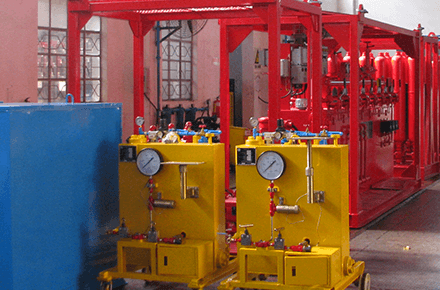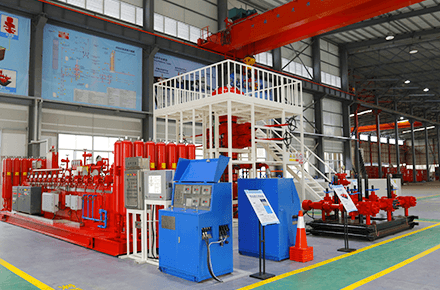In the oil and gas industry, safety is paramount, especially during drilling operations. A fundamental component of safety protocols on oil rigs is the blowout preventer (BOP). This critical piece of equipment serves as the last line of defense against uncontrolled releases of oil or gas, which can lead to catastrophic blowouts. Selecting the right blowout preventer for your oil rig is therefore not just a matter of compliance but is crucial for maintaining operational integrity, protecting personnel, and minimizing environmental impact.

At its core, a blowout preventer is a large, heavy-duty piece of machinery designed to control wellbore pressure during drilling operations. It serves as a barrier between the wellbore and the drilling rig, preventing the uncontrolled release of oil or gas in the event of a blowout. Blowout preventers come in various types and configurations, each tailored to specific drilling conditions and well designs.
The primary function of a blowout preventer is to seal off the wellbore and control pressure within the well during drilling operations. In the event of a kick or blowout, the blowout preventer can quickly activate to shut off the flow of fluids from the well, thereby preventing a catastrophic blowout. Additionally, blowout preventers may contain mechanisms for diverting the flow of fluids away from the drilling rig to minimize the risk of ignition or explosion.
A typical blowout preventer consists of several key components, each playing a crucial role in its operation:
Hydraulic Rams: These are large, heavy-duty pistons that can be activated to close off the wellbore in the event of a blowout. Hydraulic rams are typically used in ram blowout preventers, which rely on solid, mechanical seals to shut off the flow of fluids.
Annular Elements: Annular blowout preventers utilize a flexible elastomeric element, known as an annular packing element, to create a seal around the drill pipe or casing. The annular element is capable of expanding and contracting to accommodate variations in wellbore diameter and maintain a tight seal.
Control Systems: Blowout preventers are equipped with sophisticated control systems that allow for remote operation and monitoring. These control systems may include hydraulic, pneumatic, or electric actuators, as well as sensors and monitoring devices to detect pressure changes and other anomalies.
The blowout preventer plays a crucial role in ensuring the safety and integrity of oil and gas drilling operations. By providing a reliable barrier against blowouts, blowout preventers help protect personnel, equipment, and the environment from the potentially devastating consequences of uncontrolled releases of oil or gas. In addition to their primary function of controlling pressure, blowout preventers also serve as a key component of emergency response plans, providing operators with a last line of defense in the event of an unexpected well control incident.

Several key factors should influence your decision when choosing a blowout preventer for your oil rig:
Wellbore Conditions: The characteristics of the wellbore, including depth, diameter, formation pressure, and temperature, are critical considerations. These factors dictate the size, pressure rating, and sealing capacity required of the blowout preventer to effectively control pressure and prevent blowouts.
Operating Environment: The operating environment, including water depth, temperature variations, and pressure fluctuations, plays a significant role in selecting the appropriate blowout preventer. Offshore rigs, for example, may require blowout preventers specifically designed for deepwater applications, capable of withstanding high pressures and corrosive conditions.
Regulatory Compliance: Compliance with regulatory standards and industry best practices is non-negotiable. Regulatory requirements vary by jurisdiction but typically include standards set by organizations such as the American Petroleum Institute (API) and the International Association of Drilling Contractors (IADC). Ensure that the chosen blowout preventer meets or exceeds relevant standards and certifications to ensure safety and environmental protection.
Reliability and Performance: Reliability is paramount when it comes to blowout preventers. Opt for a reputable manufacturer with a proven track record of producing reliable and high-performance equipment. Consider factors such as maintenance requirements, spare parts availability, and the manufacturer's support network when evaluating the reliability of a blowout preventer. Additionally, assess the performance characteristics of the blowout preventer under various operating conditions to ensure it meets your specific needs.
Based on the factors above, it's essential to select the appropriate type of blowout preventer for your oil rig:
Ram Blowout Preventers: Ram blowout preventers are well-suited for sealing off the wellbore in a variety of conditions, including high-pressure and high-temperature environments. They are available in different configurations, including single ram, double ram, and variable bore ram, offering versatility in wellbore sealing. Ram blowout preventers are particularly effective in situations where a solid, mechanical seal is required.
Annular Blowout Preventers: Annular blowout preventers excel in sealing irregularly shaped wellbores and accommodating a wide range of casing sizes. They create a seal by applying pressure to a flexible elastomeric element, which expands to conform to the shape of the wellbore. Annular blowout preventers offer the advantage of being able to maintain a seal even if the wellbore undergoes changes in pressure or temperature.
Once a blowout preventer has been selected and installed on the oil rig, ongoing maintenance and training are critical to ensuring its effectiveness and reliability:
Regular maintenance inspections should be conducted to identify and address any potential issues before they escalate into safety hazards. This includes inspecting hydraulic systems, seals, control systems, and other critical components for signs of wear, corrosion, or damage. Scheduled maintenance should be performed in accordance with the manufacturer's recommendations and industry best practices to ensure the continued performance of the blowout preventer.
Furthermore, personnel responsible for operating and maintaining the blowout preventer should undergo comprehensive training. Training programs should cover the operation of the blowout preventer, maintenance procedures, troubleshooting techniques, and emergency response protocols. Well-trained personnel are essential for ensuring the safe and effective operation of the blowout preventer and responding appropriately to any unforeseen circumstances or emergencies.
Choosing the right blowout preventer for your oil rig is a critical decision that requires careful consideration of various factors, including wellbore conditions, operating environment, regulatory compliance, reliability, and performance. By selecting a blowout preventer that is well-suited to your specific drilling requirements and adheres to industry best practices, you can mitigate the risk of blowouts and protect the safety of personnel and the environment. Regular maintenance and training are essential for ensuring the ongoing effectiveness and reliability of the blowout preventer throughout its operational lifespan.
By continuing to use the site you agree to our privacy policy Terms and Conditions.